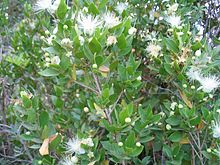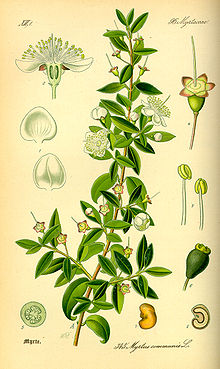- Myrtus
-
For the main belt asteroid, see 9203 Myrtus.
Myrtle 
Myrtus communis 
Myrtle (M. communis). Scientific classification Kingdom: Plantae (unranked): Angiosperms (unranked): Eudicots (unranked): Rosids Order: Myrtales Family: Myrtaceae Genus: Myrtus
L.Species Myrtus communis L.
Myrtus nivellei Batt. & Trab.Myrtus (myrtle) is a genus of one or two species of flowering plants in the family Myrtaceae, native to southern Europe and north Africa. The plant is an evergreen shrub or small tree, growing to 5 m tall. The leaf is entire, 3–5 cm long, with a fragrant essential oil. The star-like flower has five petals and sepals, and numerous stamens. Petals usually are white. The fruit is a round blue-black berry containing several seeds. The flower is pollinated by insects, and the seeds are dispersed by birds that eat the berries.
The common myrtle Myrtus communis, also called true myrtle, is widespread in the Mediterranean region and is commonly cultivated. The other species, Saharan myrtle M. nivellei, is restricted to the Tassili n'Ajjer mountains in southern Algeria and the Tibesti Mountains in Chad, where it occurs in small areas of sparse relict woodland near the centre of the Sahara Desert; it is listed as an endangered species. However, some botanists are not convinced that M. nivellei is sufficiently distinct to be treated as a separate species.
Contents
Modern uses
Myrtle is cultivated as an ornamental garden shrub, particularly for its numerous flowers in later summer. It may be clipped to form a hedge.
It is used in the islands of Sardinia and Corsica to produce an aromatic liqueur called "Mirto" by macerating it in alcohol. Mirto is known as one of the most typical drinks of Sardinia and comes in two varieties: "Mirto Rosso" (red) produced by macerating the berries, and "Mirto Bianco" (white) produced from the leaves.[1]
Medicinal uses
Myrtle occupies a prominent place in the writings of Hippocrates, Pliny, Dioscorides, Galen, and the Arabian writers.[2]
In numerous Mediterranean countries, the extract of the myrtle herb is used to make the hair grow longer in a short period of time.[citation needed]
The fresh, clear aroma of this oil is excellent at clearing the airways and as is considered safe for young and old alike. In addition a recent systematic review of herbal medicines, have proven a positive effect for myrtle compounds in the treatment of rhinosinusitis Sinusitis.[3][4] In several countries (particularly in Europe and China) there have been a tradition for prescribing this substance for sinus infections. The active substance is known as Myrtol standardized, although it is unclear what this chemical is exactly.[5] An ointment containing the essential oil myrtle was effective against herpes simplexvirus (HSV-1) infection.[6] An extract of the berries of Myrtus communis had significant ulcer-protective effects when administered to rats [7]
Uses in myth and ritual
In Greek mythology and ritual the myrtle was sacred to the goddesses Aphrodite[8] and also Demeter: Artemidorus asserts that in interpreting dreams “a myrtle garland signifies the same as an olive garland, except that it is especially auspicious for farmers because of Demeter and for women because of Aphrodite. For the plant is sacred to both goddesses.”[9] Pausanias explains that one of the Graces in the sanctuary at Elis holds a myrtle branch because “the rose and the myrtle are sacred to Aphrodite and connected with the story of Adonis, while the Graces are of all deities the nearest related to Aphrodite.” Myrtle is the garland of Iacchus, according to Aristophanes,[10] and of the victors at the Theban Iolaea, held in honour of the Theban hero Iolaus.[11]
In Rome, Virgil explains that “the poplar is most dear to Alcides, the vine to Bacchus, the myrtle to lovely Venus, and his own laurel to Phoebus.”[12] At the Veneralia, women bathed wearing crowns woven of myrtle branches, and myrtle was used in wedding rituals.
In the Mediterranean, myrtle was symbolic of love and immortality. In their culture the plant was used extensively and was considered an essential plant.
In Jewish liturgy, it is one of the four sacred plants of Sukkot, the Feast of Tabernacles representing the different types of personality making up the community - the myrtle having fragrance but not pleasant taste, represents those who have good deeds to their credit despite not having knowledge from Torah study. Three branches are held by the worshippers along with a citron, a palm leaf, and two willow branches. In Jewish mysticism, the myrtle represents the phallic, masculine force at work in the universe. For this reason myrtle branches were sometimes given the bridegroom as he entered the nuptial chamber after a wedding (Tos. Sotah 15:8; Ketubot 17a). Myrtles are both the symbol and scent of Eden (BhM II: 52; Sefer ha-Hezyonot 17). The Hechalot text Merkavah Rabbah requires one to suck on a myrtle leaves as an element of a theurgic ritual. Kabbalists link myrtle to the sefirah of Tiferet and use sprigs in their Shabbat (especially Havdalah) rites to draw down its harmonizing power as the week is initiated (Shab. 33a; Zohar Chadash, SoS, 64d; Sha’ar ha-Kavvanot, 2, pp. 73–76).[13]
In neo-pagan and wicca rituals, myrtle, though not indigenous beyond the Mediterranean Basin, is now commonly associated with and sacred to Beltane (May Day).
Myrtle in a wedding bouquet is a general European custom.[14] Crowns of myrtle are used in the Ukrainian wedding ceremony.
A sprig of myrtle from Queen Victoria's wedding bouquet was planted as a slip,[15] and sprigs from it have continually been included in royal wedding bouquets.
Garden history
Because of its elegance of habit, appealing odour, and amenity to clipping by the topiarius, as much as for sacred associations, the myrtle was an indispensable feature of Roman gardens. As a reminder of home, it will have been introduced wherever Roman elites were settled, even in areas of the Mediterranean Basin where it was not already endemic: "the Romans... must surely have attempted to establish a shrub so closely associated with their mythology and tradition," observes Alice Coats.[16] In Gaul and Britannia it will not have proved hardy. In England it was reintroduced in the 16th century, traditionally with the return from Spain in 1585 of Sir Walter Raleigh and Sir Francis Carey, who also brought with them the first orange trees seen in England. Myrtus communis will have needed similar protection from winter cold and wet. Alice Coats[17] notes an earlier testimony: in 1562 Elizabeth's great minister Lord Burghley wrote to Mr Windebank in Paris to ask him for a lemon, a pomegranate and a myrtle, with instructions for their culture— which suggests that the myrtle, like the others, was not yet familiar.
By 1597 John Gerard lists six varieties being grown in southern England.,[18] and by 1640 John Parkinson noted a double-flowering one. Alice Coats suggests that this was the very same double that the diarist and gardener John Evelyn noted "was first discovered by the incomparable Fabr. Piereshy, which a mule had cropt from a wild shrub." In the late 17th and early 18 century myrtles in cases, pots and tubs were brought out to summer in the garden and wintered with other tender greens in an orangery. Fairchild, The City Gardener (1722) notes their temporary use, rented from a nurseryman annually to fill an empty fireplace in the warm months.
With the influx to England of more dramatic tender plants and shrubs from Japan or Peru in the 19th century, it was more difficult to find room for the Common Myrtle of borderline hardiness.
Related plants
Many other related species native to South America, New Zealand and elsewhere, previously classified in a wider interpretation of the genus Myrtus, are now treated in other genera, Eugenia, Lophomyrtus, Luma, Rhodomyrtus, Syzygium, Ugni, and at least a dozen other genera. The name "myrtle" is also used to refer to unrelated plants in several other genera: "Crape myrtle" (Lagerstroemia, Lythraceae), "Wax myrtle" (Morella, Myricaceae), and "Myrtle" or "Creeping myrtle" (Vinca, Apocynaceae).
Footnotes
- ^ "Liquore di mirto" (in Italian). Italian Wikipedia. http://it.wikipedia.org/wiki/Liquore_di_mirto. Retrieved 2007-06-18.
- ^ Pharmacographia Indica (1891 edition), London
- ^ Guo R., Canter PH., Ernst E.: “Herbal medicines for the treatment of rhinosinusitis: a systematic review”. Otolaryngol Head Neck Surg. 2006 Oct.; 135 (4): 496–506 PMID 17011407
- ^ Rantzsch, U & Vacca, G & Dück, R & Gillissen, A. (2009). "Anti-inflammatory effects of Myrtol standardized and other essential oils on alveolar macrophages from patients with chronic obstructive pulmonary disease". European journal of medical research, 14 Suppl 4. PMID 20156758
- ^ Beipackzettel von GeloMyrtol® forte
- ^ Zolfaghari M.E., Salamian P., Riazi A., Khaksa A."Clinical trial of efficacy of myrtle oil in the treatment of herpex simplex" Iranian Journal of Medical Sciences 1997 22:3-4 (134-137)
- ^ Sumbul S, Ahmad MA, Asif M, Saud I, Akhtar M, "Evaluation of Myrtus communis Linn. berries (common myrtle) in experimental ulcer models in rats." Hum Exp Toxicol. 2010 November 29(11):935-44 PMID: 20594998
- ^ V. Pirenne-Delforge, “Épithètes cultuelles et interpretation philosophique: à propos d’Aphrodite Ourania et Pandémos à Athènes.” AntCl 57 (1980::142-57) p. 413.
- ^ Artemidorus, Oneirocritica, I.77. (translation of Hugh G. Evelyn-White).
- ^ Aristophanes, The Frogs, the Iacchus chorus, 330ff.
- ^ Pindar, Isthmian Ode IV.
- ^ Virgil, Eclogue VII.61-63.
- ^ List of plants in the Bible
- ^ Marcel De Cleene, Marie Claire Lejeune, eds. Compendium of symbolic and ritual plants in Europe Volume 1, 2003:444.
- ^ "in a churchyard at Cowes, on the Isle of Wight" according to Vivian A. Rich, Cursing the Basil: And Other Folklore of the Garden 1998:18.
- ^ Alice M. Coats, Garden Shrubs and Their Histories (1964) 1992, s.v. "Myrtus".
- ^ Coats (1964) 1992.
- ^ Gerard, The Herball, 1597.
External links
Wikimedia Commons has media related to: - Myrtle (Myrtus communis L.), from Gernot Katzer's Spice Pages
- www.myrtus-communis.de (German)
- Myrtus in Flora Europaea
Categories:- Myrtus
- Flora of the Mediterranean
- Flora of Europe
- Flora of the Sahara
- Flora of Northern Africa
- Matorral shrubland
- Medicinal plants
- Garden plants of Europe
- Garden plants of Africa
- Shrubs
- Drought-tolerant plants
- Bird food plants
Wikimedia Foundation. 2010.

